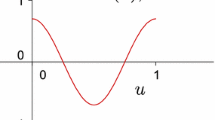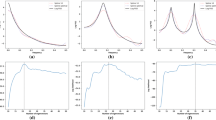Abstract
Various methods for estimating the self-similarity parameter (Hurst parameter, H) of a Hurst–Kolmogorov stochastic process (HKp) from a time series are available. Most of them rely on some asymptotic properties of processes with Hurst–Kolmogorov behaviour and only estimate the self-similarity parameter. Here we show that the estimation of the Hurst parameter affects the estimation of the standard deviation, a fact that was not given appropriate attention in the literature. We propose the least squares based on variance estimator, and we investigate numerically its performance, which we compare to the least squares based on standard deviation estimator, as well as the maximum likelihood estimator after appropriate streamlining of the latter. These three estimators rely on the structure of the HKp and estimate simultaneously its Hurst parameter and standard deviation. In addition, we test the performance of the three methods for a range of sample sizes and H values, through a simulation study and we compare it with other estimators of the literature.










Similar content being viewed by others
References
Beran J (1994) Statistics for long-memory processes. Monographs on statistics and applied probability, vol 61. Chapman and Hall, New York
Bouette JC, Chassagneux JF, Sibai D, Terron R, Charpentier R (2006) Wind in Ireland: long memory or seasonal effect. Stoch Environ Res Risk Assess 20(3):141–151
Coeurjolly JF (2008) Hurst exponent estimation of locally self-similar Gaussian processes using sample quantiles. Ann Statist 36(3):1404–1434
Cox DR, Reid N (1987) Parameter orthogonality and approximate conditional inference. J R Stat Soc Ser B 49(1):1–39
Doukhan P, Oppenheim G, Taqqu M (2003) Theory and applications of long-range dependence. Birkhauser, Boston
Ehsanzadeh E, Adamowski K (2010) Trends in timing of low stream flows in Canada: impact of autocorrelation and long-term persistence. Hydrol Process 24:970–980
Embrechts P, Maejima M (2002) Self similar processes. Princeton University Press, Princeton
Esposti F, Ferrario M, Signorini MG (2008) A blind method for the estimation of the Hurst exponent in time series: theory application. Chaos 18(3). doi:10.1063/1.2976187
Grau-Carles P (2005) Tests of long memory: a bootstrap approach. Stoch Environ Res Risk Assess 25(1–2):103–113
Guerrero A, Smith L (2005) A maximum likelihood estimator for long-range persistence. Phys A 355(2–4):619–632
Hurst HE (1951) Long term storage capacities of reservoirs. Trans ASCE 116:776–808
Kolmogorov AE (1940) Wienersche Spiralen und einige andere interessante Kurven in Hilbertschen Raum. Dokl Akad Nauk URSS 26:115–118
Koutsoyiannis D (2003a) Climate change, the Hurst phenomenon, and hydrological statistics. Hydrol Sci J 48(1):3–24
Koutsoyiannis D (2003b) Internal report. http://www.itia.ntua.gr/getfile/537/2/2003HSJHurstSuppl.pdf
Koutsoyiannis D, Montanari A (2007) Statistical analysis of hydroclimatic time series: uncertainty and insights. Water Resour Res 43(5): W05429. doi:10.1029/2006WR005592
Mandelbrot BB, JW van Ness (1968) Fractional Brownian motion, fractional noises and applications. SIAM Rev 10:422–437
McLeod AI, Hippel K (1978) Preservation of the rescaled adjusted range. 1. A reassessment of the Hurst phenomenon. Water Resour Res 14(3):491–508
McLeod AI, Yu H, Krougly Z (2007) Algorithms for linear time series analysis: With R package. J Stat Softw 23(5):1–26
Mielniczuk J, Wojdyllo P (2007) Estimation of Hurst exponent revisited. Comput Stat Data Anal 51(9):4510–4525
Musicus B (1988) Levinson and fast Cholesky algorithms for Toeplitz and almost Toeplitz matrices. RLE Technical Report No. 538. Research Laboratory of Electronics Massachusetts Institute of Technology, Cambridge
Palma W (2007) Long-memory time series theory and methods. Wiley Interscience, New York
Rea W, Oxley L, Reale M, Brown J (2009) Estimators for long range dependence: an empirical study. Electronic J Stat. arXiv:0901.0762v1
Robert C (2007) The Bayesian choice: from decision-theoretic foundations to computational implementation. Springer, New York
Robinson PM (1995) Gaussian semiparametric estimation of time series with long-range dependence. Ann Stat 23:1630–1661
Robinson PM (2003) Time series with long memory. Oxford University Press. Oxford
Taqqu M, Teverovsky V, Willinger W (1995) Estimators for long-range dependence: an empirical study. Fractals 3(4):785–798
Weron R (2002) Estimating long-range dependence: finite sample properties and confidence intervals. Phys A 312(1–2):285–299
Zhang Q, Xu CY, Yang T (2009) Scaling properties of the runoff variations in the arid and semi-arid regions of China: a case study of the Yellow River basin. Stoch Environ Res Risk Assess 23(8):1103–1111
Acknowledgements
The authors wish to thank two anonymous reviewers for their constructive comments.
Author information
Authors and Affiliations
Corresponding author
Appendices
Appendix A: Proof of Eqs. 8 and 9
From Eq. 7 we obtain:
Since e T R −1 e > 0 (R is positive definite matrix) the maximum of p(θ|x n ) is achieved when
For that value of μ, taking the logarithm of the posterior density we obtain:
Thus, the logarithm of the maximum posterior density is maximized when \( {\frac{{\partial { \ln }[p\left( {{\varvec{\uptheta}}|{\mathbf{x}}_{n} } \right)]}}{\partial \sigma }} = 0 \). The solution of this equation proves Eq. 8 and gives the ML estimator of σ.
Substituting the values of μ and σ from Eq. 8, we obtain:
which is a function of H through the matrix R. So we maximize the above single-variable function, or equivalently the function g 1(H), and find \( \hat{H} \).
We may observe that it is not necessary to form the entire matrix R and invert it to compute g 1(H) (It suffices to form a column (ρ0 … ρn−1)T). Since R is a positive definite Toeplitz matrix we can use the Levinson–Trench–Zohar algorithm as described in Musicus (1988). This algorithm can solve the problem of calculating R −1 e and ln[det(R)] using only O(n 2) operations and O(n) storage. In contrast, standard methods such as Gaussian elimination or Choleski decomposition generally require O(n 3) operations and O(n 2) storage. This is of critical importance when the time series size is large and computer memory capacity restricts its ability to solve the problem.
Appendix B: Proof of the bracketing of the H in (0, 1] in the LSV solution
In order to examine the behaviour of \( \hat{\sigma } \) and g 2(H) from Eqs. 21 and 22 we calculate the following limits:
Therefore, there is a possibility that g 2(H) could have a minimum for H = 1 and σ = ∞, when σ tends to infinity from this path: \( \sigma = \sqrt {\alpha_{12}({H})/\alpha_{11} ({H}) } \)
Then \( \begin{gathered}\mathop {\lim }\limits_{H \to 1} {{g}}_{ 2}({{H) = }}\sum\limits_{k = 1}^{k'} {{\frac{{s^{4(k)} }}{{k^{p} }}}- \left( {\sum\limits_{k = 1}^{k'} {{\frac{{\ln (n/k)k^{2}s^{2(k)} }}{{k^{p} }}} } } \right)^{2}\mathord{\left/ {\vphantom{{} {}}} \right. \kern-\nulldelimiterspace}\left( {\sum\limits_{k= 1}^{k'} {{\frac{{\ln (n/k)k^{2} }}{{k^{p} }}}} } \right) }\hfill \\ \hfill \\ \end{gathered} \)
Now we prove e 2(σ, H) attains its minimum for H ≤ 1. The proof is given bellow:
Suppose that H 2 > 1 and σ 2 > 0 (It’s easy to prove that an estimated \( \hat{\sigma } > 0 \) always). Now for any H 1 ∈ (0, 1) we can always find a σ 1 > 0, such that c k (H 1) \( k^{{ 2H_{1} }} \) \( \sigma_{1}^{2} \) − s 2(k) < 0 for every k. For these values of H 1 and σ 1: | c k (H 1) \( k^{{ 2H_{1} }} \) \( \sigma_{1}^{2} \) − s 2(k) | < | c k (H 2) \( k^{{ 2H_{ 2} }} \) \( \sigma_{2}^{2} \) − s 2(k) | for every k. This proves that e 2(σ1, H 1) < e 2(σ2, H 2). Thus, e 2(σ, H) attains its minimum for H ≤ 1.
Appendix C: Calculation of Fisher Information Matrix’s elements
We can easily calculate the I 12(θ), I 13(θ) and I 23(θ) elements of the Fisher Information Matrix (Robert 2007, p. 129):
The expectations of the above expressions are easily calculated and give the corresponding elements of the Fisher Information Matrix I(θ).
Rights and permissions
About this article
Cite this article
Tyralis, H., Koutsoyiannis, D. Simultaneous estimation of the parameters of the Hurst–Kolmogorov stochastic process. Stoch Environ Res Risk Assess 25, 21–33 (2011). https://doi.org/10.1007/s00477-010-0408-x
Published:
Issue Date:
DOI: https://doi.org/10.1007/s00477-010-0408-x




